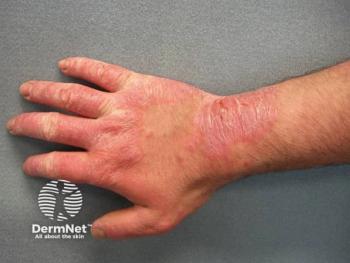
FDA Grants Orphan Drug Designation to Dusquetide for Behçet’s Disease
Key Takeaways
- Dusquetide, an innate defense regulator, modulates immune responses, showing promise in treating Behçet’s disease with significant efficacy and safety in a phase 2a study.
- Orphan drug designation provides benefits like market exclusivity and tax credits, strengthening dusquetide's development path and intellectual property protections.
Orphan designation provides Soligenix with potential regulatory, financial, and exclusivity benefits as it develops SGX945.
Today, the US Food and Drug Administration (FDA) granted orphan drug designation to dusquetide, the active ingredient in Soligenix’s investigational therapy SGX945, for the treatment of Behçet’s disease. The decision follows encouraging results from a phase 2a pilot study that demonstrated biological efficacy and safety in patients with this rare and difficult to treat autoimmune disorder.1,2
Orphan Drug Designation and Implications
The Orphan Drug Act was established to incentivize development of treatments for conditions affecting fewer than 200,000 people in the US. Orphan designation provides a number of potential benefits for drug developers, including 7 years of market exclusivity upon approval, eligibility for government grants, waiver of certain FDA user fees, and access to tax credits related to clinical trial expenses.
For Soligenix, this designation strengthens the development path of dusquetide while expanding its intellectual property protections. The company’s CEO, Christopher J. Schaber, PhD, emphasized the importance of the designation: "Behçet's Disease is an area of unmet medical need, with up to 18,000 people in the US, 50,000 in Europe, 350,000 people in Turkey and as many as 1 million people worldwide affected by this incurable disease. Given the clinically meaningful improvements seen in a phase 2 proof-of-concept study in patients with oral aphthous ulcers due to Behçet's Disease, we are hopeful dusquetide will have a role to play in helping underserved patients suffering from this difficult to treat and chronic auto-immune disease. The FDA's decision to grant orphan drug designation to the SGX945 program signifies an important step for Soligenix as we continue to advance the program and adds significantly to the existing intellectual property estate surrounding this novel technology."
Dusquetide
Dusquetide belongs to a new class of short synthetic peptides known as innate defense regulators (IDRs). Unlike traditional antibiotics, IDRs do not directly target pathogens but instead modulate the host immune response, shifting it toward anti-inflammatory, anti-infective, and tissue-healing pathways. Preclinical studies have shown activity across a range of models, including mucositis, colitis, macrophage activation syndrome, and bacterial infections, with additional evidence suggesting potential anti-tumor effects.
Clinical testing has further supported dusquetide’s safety and efficacy. A phase 1 study in 84 healthy volunteers found the therapy to be well-tolerated, while larger phase 2 and 3 studies in more than 350 patients with oral mucositis due to head and neck cancer demonstrated clinical benefit.3
Phase 2a Study in Behçet’s Disease
The orphan designation was informed by a small, open-label phase 2a pilot study involving 8 patients with Behçet’s disease who were treated with SGX945 for oral aphthous ulcers. Study endpoints were aligned with those used in the pivotal phase 3 trial of apremilast (Otezla; Amgen), the only FDA-approved drug for Behçet’s disease.5
At 4 weeks, patients receiving SGX945 showed a 40% improvement relative to the placebo arm from the prior apremilast trial, compared with 37% improvement observed with apremilast. Notably, the SGX945 group maintained a 32% improvement at week 8, even after treatment had been discontinued at week 4. By contrast, apremilast required continuous treatment through week 12 to maintain a 41% improvement. One patient with a skin ulcer also experienced resolution of the lesion during therapy, an outcome considered challenging with current treatment approaches.
Importantly, SGX945 was well-tolerated with no treatment-related adverse events. This safety profile contrasts with the known adverse effects of apremilast, which include diarrhea, nausea, and headache in a significant proportion of patients.
Behçet’s Disease and Current Treatment Landscape
Behçet’s disease is a chronic, relapsing vasculitis most commonly diagnosed in young adults. Its hallmark features include recurrent oral ulcers (seen in roughly 95% of patients), genital ulcers, skin lesions, eye inflammation, and leg ulcers. The disease has a profound impact on patient quality of life and carries risks of long-term complications such as scarring, organ damage, and post-thrombotic syndrome.1
Current therapies focus on symptom management and flare suppression. Corticosteroids are frequently used but limited by toxicity with chronic administration. Immunosuppressive agents such as cyclosporine and cyclophosphamide can reduce inflammation but carry risks of infection and organ toxicity. Biologic anti-TNF therapies and apremilast represent other options, though adverse effects and high treatment costs remain barriers.
Outlook
The FDA’s orphan designation of dusquetide for Behçet’s disease highlights the potential of innate defense regulation as a novel therapeutic strategy. While the phase 2a data are preliminary and derived from a small patient population, the findings suggest clinically meaningful efficacy and favorable tolerability.
Further studies will be needed to confirm these results in larger patient groups and to assess long-term outcomes. If validated, SGX945 may represent an important new treatment option for a patient population with limited alternatives and substantial unmet medical need.
References
- FDA grants soligenix orphan drug designation for the treatment of Behçet's disease after reviewing recent phase 2 clinical study results. News release. Soligenix. Published August 18, 2025. Accessed August 18, 2025. https://ir.soligenix.com/2025-08-18-FDA-Grants-Soligenix-Orphan-Drug-Designation-for-the-Treatment-of-Behcets-Disease-after-Reviewing-Recent-Phase-2-Clinical-Study-Results
- Biological efficacy demonstrated in a phase 2 clinical trial of SGX945 for the treatment of Behçet's disease. News release. Soligenix. Published July 31, 2025. Accessed August 18, 2025. https://ir.soligenix.com/2025-07-31-Biological-Efficacy-Demonstrated-in-a-Phase-2-Clinical-Trial-of-SGX945-for-the-treatment-of-Behcets-Disease
- North JR, Takenaka S, Rozek A, Kielczewska A, Opal S, Morici LA, Finlay BB, Schaber CJ, Straube R, Donini O. A novel approach for emerging and antibiotic resistant infections: Innate defense regulators as an agnostic therapy. J Biotechnol. 2016 May 20;226:24-34. doi: 10.1016/j.jbiotec.2016.03.032. Epub 2016 Mar 23. PMID: 27015977; PMCID: PMC4867239.
- FDA approves OTEZLA® (apremilast) for the treatment of oral ulcers associated with Behçet’s disease. News release. Celgene. Published July 19, 2019. Accessed August 18, 2025. https://www.biospace.com/fda-approves-otezla-apremilast-for-the-treatment-of-oral-ulcers-associated-with-behcet-s-disease
Newsletter
Like what you’re reading? Subscribe to Dermatology Times for weekly updates on therapies, innovations, and real-world practice tips.



















